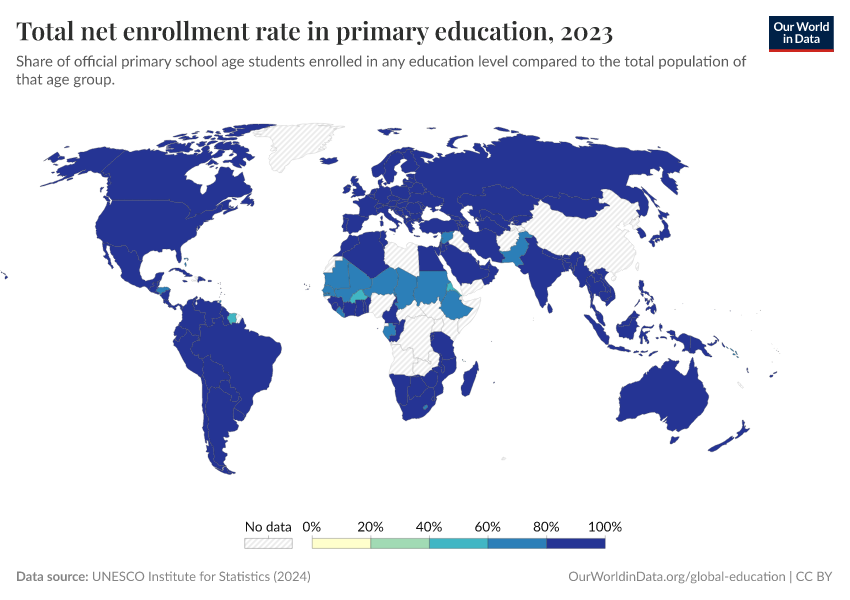Net enrolment rate in primary education

What you should know about this indicator
- The net enrolment rate shows what percentage of children are enrolled at the education level intended for their age. Unlike gross enrolment, it only counts students who are within the official age range for that level.
- It compares children enrolled at the correct level for their age to the total population in that same age group. For example, if primary education is for ages 6 to 11, it measures how many 6- to 11-year-olds are actually enrolled in primary school.
- The highest possible value is 100%, which would mean all children of the right age are enrolled where they should be. High rates indicate that most children are progressing through school at the expected pace.
- Values cannot exceed 100% because it excludes over-age and under-age students. However, small discrepancies between enrolment records and population data can occasionally push rates slightly above 100%.
- A rate of 90% doesn't necessarily mean 10% of children are out of school entirely - some may be enrolled at different levels (either higher or lower) than expected for their age, but these students aren't counted in the net rate.
- The data comes from school administrative records that track enrolment by individual age, combined with population estimates from national statistics offices or UN sources.
Sources and processing
This data is based on the following sources
How we process data at Our World in Data
All data and visualizations on Our World in Data rely on data sourced from one or several original data providers. Preparing this original data involves several processing steps. Depending on the data, this can include standardizing country names and world region definitions, converting units, calculating derived indicators such as per capita measures, as well as adding or adapting metadata such as the name or the description given to an indicator.
At the link below you can find a detailed description of the structure of our data pipeline, including links to all the code used to prepare data across Our World in Data.
Reuse this work
- All data produced by third-party providers and made available by Our World in Data are subject to the license terms from the original providers. Our work would not be possible without the data providers we rely on, so we ask you to always cite them appropriately (see below). This is crucial to allow data providers to continue doing their work, enhancing, maintaining and updating valuable data.
- All data, visualizations, and code produced by Our World in Data are completely open access under the Creative Commons BY license. You have the permission to use, distribute, and reproduce these in any medium, provided the source and authors are credited.
Citations
How to cite this page
To cite this page overall, including any descriptions, FAQs or explanations of the data authored by Our World in Data, please use the following citation:
“Data Page: Net enrolment rate in primary education”, part of the following publication: Hannah Ritchie, Veronika Samborska, Natasha Ahuja, Esteban Ortiz-Ospina, and Max Roser (2023) - “Global Education”. Data adapted from UNESCO Institute for Statistics. Retrieved from https://archive.ourworldindata.org/20250625-161807/grapher/total-net-enrollment-rate-in-primary-education.html [online resource] (archived on June 25, 2025).How to cite this data
In-line citationIf you have limited space (e.g. in data visualizations), you can use this abbreviated in-line citation:
UNESCO Institute for Statistics (2025) – with minor processing by Our World in DataFull citation
UNESCO Institute for Statistics (2025) – with minor processing by Our World in Data. “Net enrolment rate in primary education” [dataset]. UNESCO Institute for Statistics, “UNESCO Institute for Statistics (UIS) - Education” [original data]. Retrieved August 3, 2025 from https://archive.ourworldindata.org/20250625-161807/grapher/total-net-enrollment-rate-in-primary-education.html (archived on June 25, 2025).